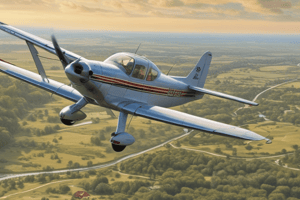Podcast
Questions and Answers
What must pilots continuously assess during flight?
What must pilots continuously assess during flight?
- Fuel capacity, passenger load, and weather patterns
- Altitude, wind speed, and flight duration
- Groundspeed, cross-track error, and ETE (correct)
- Throttle position, cockpit temperature, and autopilot status
Which instrument is NOT mentioned as being used by pilots to assess flight conditions?
Which instrument is NOT mentioned as being used by pilots to assess flight conditions?
- Fuel flow meter
- Electronic flight computer
- Barometric altimeter (correct)
- GPS groundspeed readout
What adjustment might pilots make if they encounter stronger headwinds than expected?
What adjustment might pilots make if they encounter stronger headwinds than expected?
- Adjust their estimated time en route upwards
- Reduce airspeed for better fuel economy
- Increase throttle to maintain planned fuel consumption (correct)
- Decrease altitude to avoid turbulence
Why is mastery of wind effects crucial in cross-country VFR navigation?
Why is mastery of wind effects crucial in cross-country VFR navigation?
Which of the following is NOT a reason pilots may need to consider alternate airports?
Which of the following is NOT a reason pilots may need to consider alternate airports?
What is the purpose of recalculating the wind correction angle (WCA)?
What is the purpose of recalculating the wind correction angle (WCA)?
Which factor is critical for accurate fuel planning during a flight?
Which factor is critical for accurate fuel planning during a flight?
What might indicate the need for in-flight adjustments during a flight?
What might indicate the need for in-flight adjustments during a flight?
In the case of a diversion, what additional consideration must pilots account for?
In the case of a diversion, what additional consideration must pilots account for?
A headwind will increase groundspeed if the airspeed remains constant.
A headwind will increase groundspeed if the airspeed remains constant.
The relationship between airspeed and groundspeed is not affected by wind conditions.
The relationship between airspeed and groundspeed is not affected by wind conditions.
Fuel consumption calculations in aircraft are independent of anticipated flight time.
Fuel consumption calculations in aircraft are independent of anticipated flight time.
Pilots must correct their heading only for tailwinds during flight.
Pilots must correct their heading only for tailwinds during flight.
Understanding wind effects is essential for fuel planning.
Understanding wind effects is essential for fuel planning.
Tailwinds can potentially increase flight time and fuel needs.
Tailwinds can potentially increase flight time and fuel needs.
Making in-flight adjustments is a crucial skill solely for takeoff and landing phases.
Making in-flight adjustments is a crucial skill solely for takeoff and landing phases.
Groundspeed refers to the speed of the aircraft relative to the surrounding air.
Groundspeed refers to the speed of the aircraft relative to the surrounding air.
Crosswinds require pilots to maintain a constant heading.
Crosswinds require pilots to maintain a constant heading.
Pilot proficiency requires a thorough understanding of wind effects during cross-country flights.
Pilot proficiency requires a thorough understanding of wind effects during cross-country flights.
How do unexpected wind conditions affect a pilot's in-flight calculations?
How do unexpected wind conditions affect a pilot's in-flight calculations?
What role do cockpit instruments like GPS groundspeed readouts play during flight?
What role do cockpit instruments like GPS groundspeed readouts play during flight?
In what scenarios might pilots need to reassess fuel status during a flight?
In what scenarios might pilots need to reassess fuel status during a flight?
Why is accurate calculation of fuel consumption critical for pilots?
Why is accurate calculation of fuel consumption critical for pilots?
What factors must pilots assess to maintain their intended flight path?
What factors must pilots assess to maintain their intended flight path?
How do tailwinds influence a pilot's flight planning?
How do tailwinds influence a pilot's flight planning?
What is the significance of recalculating the wind correction angle (WCA) in flight?
What is the significance of recalculating the wind correction angle (WCA) in flight?
What must pilots consider if they are diverted to alternate airports?
What must pilots consider if they are diverted to alternate airports?
Why is it important for pilots to master the relationship between airspeed and groundspeed?
Why is it important for pilots to master the relationship between airspeed and groundspeed?
What is the impact of stronger than anticipated headwinds on a flight's fuel requirements?
What is the impact of stronger than anticipated headwinds on a flight's fuel requirements?
Flashcards are hidden until you start studying
Study Notes
VFR Flying Fundamentals
- Understanding airspeed: the speed of the aircraft relative to the surrounding air, crucial for maintaining lift.
- Groundspeed defined: the actual speed over the ground, vital for navigation and time estimations for reaching destinations.
- Relationship between airspeed, groundspeed, and wind: wind affects groundspeed, decreasing it when flying into a headwind and increasing it with a tailwind.
Wind Assessment Techniques
- Wind direction and speed determined through surface conditions observation, weather reports, and in-flight weather services.
- Wind Correction Angle (WCA) calculated to counteract the wind's effect on the flight path.
- Importance of accurate wind assessment for precision in fuel planning and flight safety.
Flight Planning and Adjustments
- Dynamic nature of flight planning: continuously assess wind conditions and adjust the flight path as necessary.
- Compensating for crosswinds requires angling the aircraft into the wind to maintain the intended course.
- Adjustments for headwinds mean longer time to checkpoints, while tailwinds can shorten flight duration.
Fuel Consumption Calculations
- Wind's impact on fuel efficiency: a tailwind can decrease fuel consumption while a headwind increases it due to higher thrust requirements.
- Essential formulas involve airspeed, groundspeed (affected by wind), and fuel flow rate specific to the aircraft.
- Example scenario: A planned 300 nautical miles route with a 20-knot headwind extends flight time and increases fuel needs from 25 to 30 gallons.
In-Flight Strategies
- Pilots must track groundspeed, cross-track error, and Estimated Time En Route (ETE) to waypoints.
- Unexpected wind conditions necessitate recalculating WCA and potentially adjusting throttle settings to ensure planned fuel consumption rates are met.
- In-flight adjustments involve continuous assessment of fuel status and rerouting as required.
Summary of Key Takeaways
- Mastery of wind effects on navigation is critical for VFR pilots to ensure safety and efficiency.
- Accurate fuel consumption calculations are essential for responsible flight operations.
- In-flight adjustments and a thorough understanding of wind dynamics empower pilots to maintain control of their journeys.
Understanding Wind Effects on Navigation and Fuel Consumption
- Wind is a critical factor influencing navigation, airspeed, and groundspeed during cross-country flights.
- Airspeed measures an aircraft's speed relative to the air and is crucial for maintaining lift; it is calculated using the pitot-static system.
- Groundspeed refers to the actual speed of an aircraft over the ground, essential for navigation and estimating travel time to a destination.
- A headwind reduces groundspeed, leading to longer travel times, while a tailwind increases groundspeed, allowing for quicker arrivals.
- Pilots assess wind direction and speed through surface conditions, weather reports, and in-flight services to calculate Wind Correction Angle (WCA).
- WCA helps adjust headings to counteract wind effects, ensuring accurate navigation and fuel management.
- Accurate wind assessment is vital for preventing being off-course and managing fuel levels effectively.
- Adjustments during flight are necessary as wind conditions can change; this dynamic process requires continuous attention.
- In crosswinds, pilots must steer into the wind to maintain the intended flight path, while both headwinds and tailwinds demand adjustments in flight planning.
Fuel Consumption Calculations
- Understanding wind influence on fuel consumption is a key aspect of responsible flight planning.
- Tailwinds can reduce fuel usage, while headwinds increase fuel consumption due to the need for additional thrust.
- Side winds can alter flight duration and consequently fuel burn.
- Fundamental calculations include estimating groundspeed, which affected by wind, to determine flight duration and fuel requirements.
- Practical example: For a planned route of 300 nautical miles at 120 knots, flying without wind would use 25 gallons of fuel over 2.5 hours. However, a 20-knot headwind would reduce groundspeed to 100 knots, extending flight time to 3 hours, increasing fuel needs to 30 gallons.
- Pilots must master wind-adjusted fuel calculations to ensure adequate fuel for flights, including contingency reserves.
In-Flight Adjustments and Applications
- Pilots need to make in-flight adjustments if actual wind conditions deviate from preflight forecasts.
- Reliable fuel consumption calculations are indispensable for safe flying operations, ensuring that fuel needs account for expected airspeeds and anticipated conditions.
- Mastery of these skills enables pilots to command their journey, respond to wind influences, and enhance overall flight safety and efficiency.
Understanding Airspeed and Groundspeed
- Airspeed refers to the speed of an aircraft in relation to the surrounding air, critical for maintaining lift.
- Groundspeed is the speed of the aircraft relative to the terrain below, essential for navigation and estimating arrival times.
- Wind significantly influences the relationship between airspeed and groundspeed; headwinds reduce groundspeed, while tailwinds increase it.
Wind Correction Angle (WCA)
- WCA is the angle used to adjust the aircraft's heading to compensate for wind, ensuring accurate course maintenance.
- Factors like surface conditions and weather reports assist pilots in determining wind direction and speed.
Importance of Wind Assessment
- Precise wind assessment is crucial for fuel planning; failing to account for wind can result in being off course or unexpected fuel shortages.
- Real-life scenarios demonstrate that uncorrected wind impacts can lead to increased flight times and fuel burn.
Fuel Consumption Calculations
- Fuel usage depends on airspeed, groundspeed altered by wind, and the aircraft's fuel flow rate.
- Adjusting standard calculations for wind conditions involves estimating the ground speed from weather reports.
Practical Example of Fuel Calculation
- In windless conditions, a journey of 300 nautical miles at 120 knots requires 25 gallons of fuel over 2.5 hours.
- Introducing a 20-knot headwind reduces groundspeed to 100 knots, extending the flight to 3 hours and requiring 30 gallons of fuel.
In-Flight Adjustments and Monitoring
- Pilots must continually assess groundspeed and make in-flight corrections to maintain intended course and fuel efficiency.
- Use of cockpit instruments like GPS groundspeed readouts and fuel flow meters is essential for monitoring real-time data.
Conclusion on Wind and Fuel Management
- Mastering the impact of wind is key for safe cross-country flight planning.
- Competence in calculating fuel requirements and making in-flight adjustments leads to better safety and efficiency on flights.
Studying That Suits You
Use AI to generate personalized quizzes and flashcards to suit your learning preferences.




